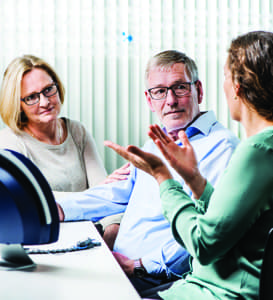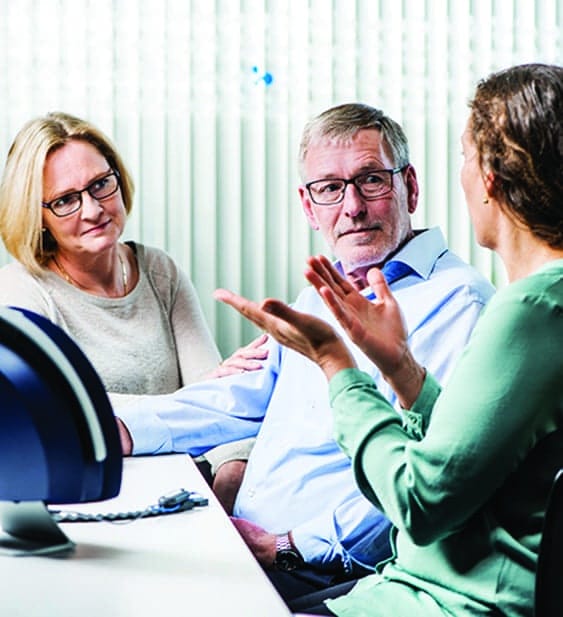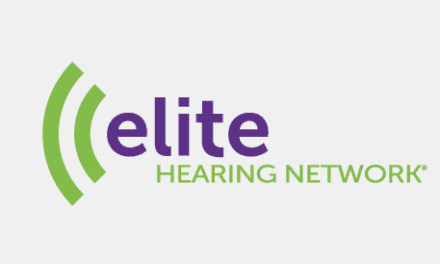Practice Management | November 2015 Hearing Review
By Peter Kossek and Jeanette Fitzke, AuD
Today, more than ever, hearing care professionals are looking for ways to stay competitive without compromising the quality of care for their patients. The authors take a closer look at the dispensing practice and offer practical advice to ensure a thriving business, elevate patient satisfaction, and maintain a competitive advantage in the changing fitting market.
The ability to deliver a viable solution to address your patients’ hearing challenges—while providing quality care and counseling—is paramount to your success as a hearing care provider. Many other factors influence your success, such as the healthcare system, clinical community, the industry, and hearing aid manufacturers, as well as the development of new technology and tools for enhanced care.
From a business perspective, continued market consolidation requires resilience to new competition and competitive hearing aid pricing. Financial stability ensures the availability of tools for workflow efficiency and productivity of the dispensing practice, and your ability to employ and retain skilled personnel. A strong revenue stream also allows for the addition of specialized services, as well as the ability to invest in new technologies and the training needed to apply advanced techniques.
So how does an independent practice keep up with the demands of today’s consumer and market? One way to cut costs is by utilizing integrated tools and procedures—and adapting to new fitting technology. The most advanced technologies today are intuitive and require less time to learn. In addition, customer service and professionalism play a key role in the patient’s overall experience. Here are three ways to help you decrease costs and sharpen your competitive edge.
1) Ensure Hearing Aid Adoption

At the core of hearing instrument adoption is counseling. Counseling is a key factor and a crucial part of the fitting cycle, especially for new patients. New patients are often in denial, uncertain, or slow to accept that they even have a problem. Taking a structured approach and using tools, such as simulators and sound libraries, helps you identify the situations that present particular challenges and select the appropriate hearing aid technology.
Counseling helps to get the patient and their relatives on board and accept the idea of a hearing instrument. For new patients and the patients who already have a hearing aid, using time for simulations, questionnaires, demonstrating the hearing instrument, and establishing a well-defined acclimatization strategy are an important part of managing the patient’s expectations and can mean the difference between success and failure with their hearing instrument. It is time well spent, as a satisfied client is more likely to recommend your clinic to others. Your reputation as a hearing care professional is a key factor not only in attracting new patients, but in attracting and retaining qualified staff.
2) Reduce the Need for Follow-up Visits
You can achieve significant cost savings by finding ways to save time by reducing the number of follow-up visits. Many hearing care professionals focus on the duration of the first visit. In fact, you should consider the time spent on the entire fitting cycle—the total number of visits and the duration of each visit. While it may sound contradictory, spending more time with your client on the first visit actually saves time in the end by reducing the unplanned troubleshooting visits that can disrupt the schedule in a busy clinic.
Verification and validation can play an important part in this. MarkeTrak VIII1 shows that verification and validation in the hearing aid fitting process can significantly reduce patient visits (1.2 fewer visits) and improve patient satisfaction. In fact, there is a direct correlation between dispensing protocols and successful patient outcomes. Therefore, while it may seem illogical to spend time to save time, spending more time on the first visit using verification (probe microphone measurements) and validation (questionnaires) can help you realize significant time-saving benefits.

Pre-fitting the hearing instrument in a hearing instrument test box using a coupler-based fitting approach before the patient comes to the clinic can also improve workflow and your patients’ experience with your service. As a result, you can use more time on counseling and verification when the patient is there to ensure the best fit, and thereby reduce the potential for many follow-up visits.
MarkeTrak VIII1 also shows 76% of patients with above-average success were fit in 1 or 2 visits; once a patient returns more than 3 times, their satisfaction with your products and services decreases. As the entire fitting process consists of multiple steps, a seamless integration between these steps and an intuitive way of handling different conditions is paramount. A streamlined workflow not only saves time, but it adds to the overall perception of quality, personal treatment, and professionalism.
3) Differentiate Your Practice
In addition to cost savings, another way to gain a competitive advantage is to take steps to differentiate yourself and your clinic. By focusing on the unique abilities of you and your staff, you can stand out from the crowd. Many parameters influence whether or not a patient will purchase a hearing aid; price is one factor, but it is not the only one.
Increasingly, dispensing professionals must find the right balance between the need to re-test existing clients who are experienced with their hearing aids versus the time it takes to get new users fully acclimatized to their devices. Leveraging available technology and a well-equipped staff, successful practices are streamlining their fitting processes. Although challenging, practice owners are also constantly updating themselves on the latest products, services, and processes available within our industry to provide the best outcomes and document them.
A recent EuroTrak study2 shows that those who have never purchased a hearing aid regard the price of the device as more important than the quality of the hearing care professional.2 However, for those who already own a hearing aid, price is not as important as the professional. Therefore, the ability to demonstrate and show the benefits of the hearing aid to both first-time and repeat users is equally important. For first-time users, it is all about setting expectations; for patients who are already using a hearing instrument, you want to use their visits, in part, to demonstrate new features and potentially upsell them to another model of hearing aid or new accessories, if beneficial.
To be able to stand out from the competition, it is important to take steps to know the new technologies available. Use equipment to show and explain hearing aid features and benefits. In addition, during fitting, be sure to include difficult listening situations and real-life sounds to make it as realistic as possible. Live demonstrations are always more credible. That is why having an advanced fitting solution that can demonstrate real-life listening situations in the fitting process can help increase client satisfaction and improve your reputation.
Gaining a Competitive Advantage Helps You Help More Patients
Your goal is to ensure your patients leave your clinic feeling confident and satisfied. You want them to know that they have chosen the right hearing instrument for their challenges, and that your expertise and skills can help them make the most of their hearing instrument.
Through better counseling, it is possible to reduce the number of returns and gain more satisfied clients who are willing to recommend you and your clinic. Using verification and validation for every patient, you can decrease the number of follow-up visits and save time on troubleshooting problems that occur because of a poor fit. Staying up to date with the latest advancements in fitting technology helps you attract and retain qualified staff and presents your clinic and the benefits of hearing care in a more professional way to your patients.
Taking these steps will help you gain a competitive edge in a changing market; more importantly, you will be able to help more people. Your time and expertise are your most important assets. Fitting tools, such as the AURICAL® by Otometrics, can help you make the most of both by streamlining every step of the fitting process. A variety of tools, including hearing instrument and hearing loss simulators and speech mapping, ensure a professional experience. Wireless modules, as well as intuitive fitting and verification tools, boost your efficiency so you can manage your time effectively. Whether it is counseling clients, supporting your staff, or planning next year’s budget, these tools take the “rocket science” out of hearing aid fitting and verification, allowing you to focus on the most important person in the room: your patient.
References
-
Kochkin S. MarkeTrak VIII: Reducing patient visits through verification and validation. Hearing Review. 2011;18(6):10-12. Available at: https://hearingreview.com/2011/06/marketrak-viii-reducing-patient-visits-through-verification-amp-validation
-
Hougaard S, Ruf S. EuroTrak I: A consumer survey about hearing aids in Germany, France and the UK. Hearing Review. 2011;18(2):12-28. Available at: https://hearingreview.com/2011/02/eurotrak-i-a-consumer-survey-about-hearing-aids-in-germany-france-and-the-uk


Correspondence can be addressed to Peter Kossek ([email protected]) or Dr Fitzke ([email protected]).
Read more fitting tips and tricks at: www.audiologysystems.com/fittingtips
Original citation for this article: Kossek P, Fitzke J. The Professional Practice: Three Ways to Stay Competitive in a Changing Market. Hearing Review. 2015;22(11):30.?






I love and appreciate your interest in exploring and discovering how we can create value for the people in our market, such that we’re seen as a good value and worth the higher cost compared with the high volume/lower cost options. However, I assert your article falls short of giving us a clear, usable access to attracting and retaining more clients. What I say is needed is clearly distinguishing the concepts you assert are missing in what we do. What I mean is concepts like “quality care,” “counseling,” “better counseling,” “structured approach,” etc., etc.. To assume there is clarity and agreement on what constitutes these is a mistake in my view. This same mistake is made in conversations on ethics in our profession. Lots of abstract concepts tossed around, but no real clarity as to what they look and sound like on the court, in reality. I’d love an opportunity to explore with you and anyone in our profession how we can not only clearly and unquestionably distinguish what’s missing that would elevate our performance, but more importantly, how to implement new ways of being and acting such that we experience the results we say we’re committed to. I can be reached at 503-292-2995